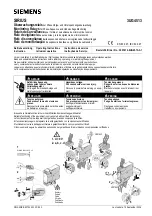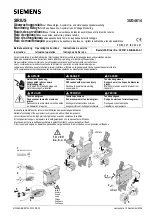
RM7895A RELAY MODULE
19
32-00122-01
3.
Close all manual main fuel shutoff valves. Check
that the automatic fuel valves are closed. Make sure
fuel is not entering the combustion chamber.
4.
Close the master switch and start the system with a
call for heat by raising the set point of the operating
controller, see Fig. 11. The primary sequence should
start the ten-second INITIATE sequence.
5.
Let the sequence advance through PREPURGE.
Ignition spark should occur after the PREPURGE
period. Listen for the click of the first stage fuel
solenoid valve(s).
6.
Let the program sequence complete its cycle.
7.
Open the manual fuel shutoff valve(s).
8.
Reset the Lockout Switch and recycle the primary
sequence through PREPURGE.
9.
Watch for the FLAME LED to help determine when
the first stage burner flame is established. If it is
established, proceed to step 15.
10.
If the first stage burner flame is not established
within four seconds, or within the normal lightoff
time specified by the equipment manufacturer, close
the manual fuel shutoff valve(s) and open the
master switch.
11.
Check all burner adjustments.
12.
Wait about three minutes. Close the master switch,
open the manual fuel shutoff valve(s), and try again
to lightoff the burner. The first attempt may have
been required to purge the lines and bring sufficient
fuel to the burner.
13.
If the first stage burner flame is not established
within four seconds, or within the normal lightoff
time specified by the equipment manufacturer, close
the manual fuel shutoff valve(s) and open the
master switch.
14.
If necessary, repeat steps 8 through 13 to establish
the first stage burner flame. Then proceed to step
15.
15.
When the first stage burner flame is established, the
sequence will advance to RUN. Make burner
adjustments for flame stability and input rating. If a
second stage is used, proceed to step 18.
16.
Shut down the system by opening the burner switch
or by lowering the set point of the operating
controller. Make sure the burner flame goes out and
make sure all automatic fuel valves close.
17.
If used, remove the bypass jumpers from the low fuel
pressure limit and subbase.
18.
If a second stage is used, make sure the automatic
second stage fuel valve(s) has opened and check the
lightoff as follows. Otherwise, proceed to step 19.
a. Open the manual second stage fuel valve(s).
b. Restart the system by raising the set point of the
operating controller.
c. When the first stage burner flame is established,
watch for the automatic second stage fuel
valve(s) to open. Observe that the second stage
lights off properly.
d. Make burner adjustments for flame stability and
input rating.
e. Shut down the system by lowering the set point
of the operating controller. Make sure the burner
flame goes out and all automatic fuel valves
close. Proceed to step 19.
19.
Restart the system by closing the burner switch
and/or raising the set point of the operating control-
ler. Observe that the burner flame is established
during PILOT IGN, within the normal lightoff time
specified by the equipment manufacturer.
20.
Measure the flame signal. Continue to check for the
proper signal, see Table 8, through the RUN period.
Any pulsating or unsteady readings will require
further attention.
21.
Make sure all readings are in the required ranges
before proceeding.
NOTE:
Upon completing these tests, open the master
switch and remove all test jumpers from the sub-
base terminals, limits/control or switches.
22.
Return the system to normal operation.
Pilot Turndown Test (All
Installations Using a Pilot)
Perform this check on all installations that use a pilot. The
purpose of this test is to verify that the main burner can be
lit by the smallest pilot flame that will hold in the flame
amplifier and energize the FLAME LED. Clean the flame
detector(s) to make sure it will detect the smallest
acceptable pilot flame.
NOTE:
Low fuel pressure limits, if used, could be open. If
so, bypass them with jumpers during this test.
1.
Open the master switch.
2.
Close the manual main fuel shutoff valve(s).
3.
Connect a manometer (or pressure gauge) to mea-
sure the pilot gas pressure during the turndown test.
4.
Open the manual pilot shutoff valve(s).
5.
Close the master switch and start the system with a
call for heat. Raise the set point of the operating
controller. The primary sequence should start and
PREPURGE should begin.
NOTE:
INTERMITTENT PILOT MODELS should continue
with step 6.
6.
INTERMITTENT PILOT MODELS—After the
sequence has entered the normal burner run period,
turn the pilot gas pressure down very slowly, reading
the manometer (or gauge) as the pressure drops.
Stop immediately when the FLAME LED goes out.
Note the pressure at this point.
a. If the Flame Failure Action jumper is not clipped:
allow the RM7895A to recycle through PRE-
PURGE. If the Flame Failure Action jumper is
clipped: push the reset push button and allow
the RM7895A to recycle through PREPURGE.
b. As the control attempts to relight the pilot, turn
the pilot gas pressure back up slowly until the
FLAME LED comes on. This step must be com-
pleted within 4 or 10 seconds, depending on the
selected PFEP, or lockout will occur.
c. Turn the pilot back down slightly but not enough
to cause the FLAME LED to go out. (Keep the gas
pressure just above the reading noted in step 6
above.)
NOTE:
Step d requires two people, one to open the man-
ual main fuel valve(s) and one to watch for igni-
tion.






































